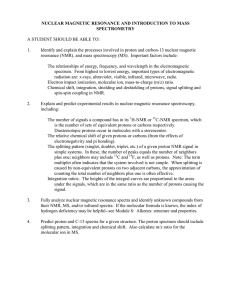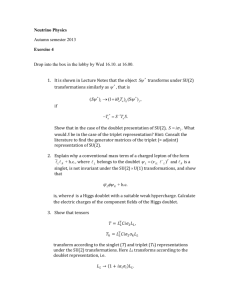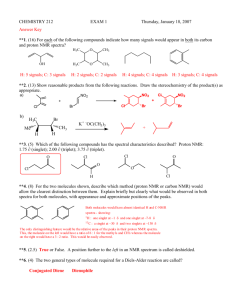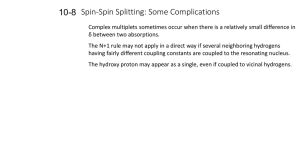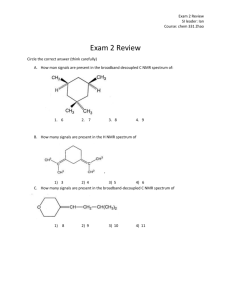NUCLEAR MAGNETIC RESONANCE AND INTRODUCTION TO MASS SPECTROMETRY
advertisement
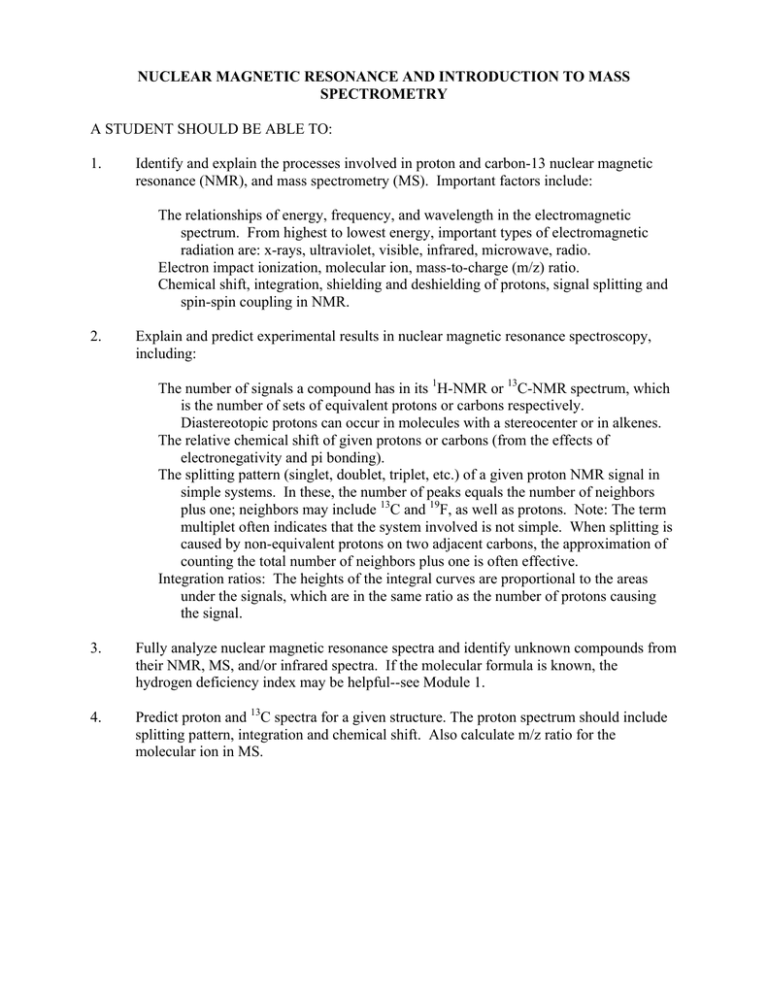
NUCLEAR MAGNETIC RESONANCE AND INTRODUCTION TO MASS SPECTROMETRY A STUDENT SHOULD BE ABLE TO: 1. Identify and explain the processes involved in proton and carbon-13 nuclear magnetic resonance (NMR), and mass spectrometry (MS). Important factors include: The relationships of energy, frequency, and wavelength in the electromagnetic spectrum. From highest to lowest energy, important types of electromagnetic radiation are: x-rays, ultraviolet, visible, infrared, microwave, radio. Electron impact ionization, molecular ion, mass-to-charge (m/z) ratio. Chemical shift, integration, shielding and deshielding of protons, signal splitting and spin-spin coupling in NMR. 2. Explain and predict experimental results in nuclear magnetic resonance spectroscopy, including: The number of signals a compound has in its 1H-NMR or 13C-NMR spectrum, which is the number of sets of equivalent protons or carbons respectively. Diastereotopic protons can occur in molecules with a stereocenter or in alkenes. The relative chemical shift of given protons or carbons (from the effects of electronegativity and pi bonding). The splitting pattern (singlet, doublet, triplet, etc.) of a given proton NMR signal in simple systems. In these, the number of peaks equals the number of neighbors plus one; neighbors may include 13C and 19F, as well as protons. Note: The term multiplet often indicates that the system involved is not simple. When splitting is caused by non-equivalent protons on two adjacent carbons, the approximation of counting the total number of neighbors plus one is often effective. Integration ratios: The heights of the integral curves are proportional to the areas under the signals, which are in the same ratio as the number of protons causing the signal. 3. Fully analyze nuclear magnetic resonance spectra and identify unknown compounds from their NMR, MS, and/or infrared spectra. If the molecular formula is known, the hydrogen deficiency index may be helpful--see Module 1. 4. Predict proton and 13C spectra for a given structure. The proton spectrum should include splitting pattern, integration and chemical shift. Also calculate m/z ratio for the molecular ion in MS. To best prepare for this module, please work Chapter 16 Skill Builder problems in the textbook. A STUDENT WHO HAS MASTERED THE OBJECTIVES ON THE PREVIOUS PAGE SHOULD BE ABLE TO SOLVE THE FOLLOWING PROBLEMS AND RELATED ONES: 1.1 a) Which of the following types of radiation has the longest wavelength? b) Which has the highest frequency? c) Which has the lowest energy? A. Microwaves 1.2 B. Infrared C. Visible Proton and carbon magnetic resonance spectra are produced by: A. Carbons and protons, respectively. C. Oxygens attached to carbon. 2.1 D. Radio B. Protons and carbons, respectively. D. Multiple bonds between carbons. How many signals are present in the proton NMR spectra of each of the following compounds? In the 13C spectra? Count similar but theoretically different benzene ring protons as different. OH | a. CH3CHCH3 O || b. CH3CH2C-O-CH2CH3 c. CH3 CH3 Br | e. CH3CH2CHCH3 g. CH 3 OCH2 CH2 OCH3 d. Cl O || CCH2 CH2 CH3 O || f. CH3CH2C-CH3 O || h. ClCH2 CO O || CCH2 Cl i. 2.2 a) Which of the following compounds has the protons having the highest chemical shift (value of delta) in this set? b) Which has the lowest chemical shift? A. (CH3)2Mg O O || || B. CH3COH C. CH3CH D. (CH3)3N 2.3 a) Which of the indicated proton(s) is (are) the most shielded (lowest value of delta)? b) Which is (are) the least shielded? O || CH3 CH2 OCCH3 A H B 2.4 What splitting pattern (singlet, doublet, triplet, quartet, quintet, etc.) is observed in the proton NMR spectrum of each of the indicated protons? CH 3 CH 2 CHBr 2 A CH 3 CH 2 C B CH 3 F D 13 13 CH22Cl Cl22 CH G 3. D C H CHCH 3 | CH 3 E F DCH2 CH 2 Cl I Identify each of the following unknowns from the given proton magnetic resonance and/or infrared spectroscopic information. a) C3H5Cl3 singlet, 2.2, 3H singlet, 4.0, 2H b) C5H10Br2 doublet, 0.9, 6H multiplet, 1.5, 1H triplet, 1.85, 2H triplet, 5.3, 1H c) C3H8O. IR: broad peak near 3400 cm-1 pmr: doublet, 1.2, 6H broad singlet, 2.0, 1H septet, 4.0, 1H d) C10H12O. IR: peak at 1710 cm–1 pmr: singlet, 2.1, 3H multiplet, 3.0, 4H multiplet, 7.1, 5H 3. e) C5H10 triplet, 0.9, 3H multiplet, 1.5, 2H quartet, 2.1, 2H multiplet, 4.8, 1H multiplet, 5.1, 1H multiplet, 5.8, 1H Note: The chapter on spectroscopy in your textbook contains a number of unknown identification problems that require you to propose a structure for a compound when given spectral data and the formula for that compound. Other problems give the spectrum itself (not merely spectral data). Problems 16.55-16.58, 16.62 and 16.64 are recommended. 4. Predict proton and 13C NMR spectra for the following compounds. Also calculate m/z ratio for their molecular ions. a) b) c) Note: Additional problems to be considered in the textbook are 16.41 and 16.42 SOLUTIONS TO SAMPLE PROBLEMS: 1.1 1.2 a) D B 2.1 Signals in the proton NMR: a) 3 b) 4 c) 2 d) 5 e) 5 f) 3 g) 2 h) 4 i) 4 In the 13C NMR: a) 2 b) 5 c) 3 d) 8 e) 4 f) 4 g) 2 h) 8 i) 3 a) B b) A a) A b) C 2.2 2.3 b) C c) D 2.4 a) triplet d) quartet g) doublet 3. a) CH3CCl2CH2Cl b) (CH3)2CHCH2CHBr2 c) (CH3)2CHOH d) b) triplet e) septet (7 peaks) h) doublet c) triplet f) doublet i) triplet O || CH2 CH2 CCH3 e) CH3CH2CH2CH=CH2 4. a) m/z 44.05 b) m/z 59.11 c) m/z 166.18 3 2 2 3 Name __________________________________ Organic Chemistry 2220D 1. First Drill Test (Sample A) Answer All Questions a) How many signals are present in the proton NMR spectra of each of the following compounds? Count similar but theoretically different benzene ring protons as different. b) How many signals are present in the C-13 NMR spectrum of each? Cl O a) _____ || CH2 CCH2 CH3 b) _____ a) _____ O || CH3 CH2 CCH2 CH3 b) _____ 2. a) What splitting pattern (singlet, doublet, triplet, etc.) is observed for each of the underlined proton(s)? b) What is the m/z ratio for the molecular ion for each of the compounds? (Atomic masses: H, 1; C, 12; F, 19; Br, 80) Br a) _____ a) _____ | CH 3 CF 2 CHCH 3 b) _____ b) _____ 3. a) Which of the following compounds gives a signal with the highest delta value (most deshielded) in the proton NMR? b) Which gives a signal with the lowest delta value? A. CH3 OCH3 4. B. C. (CH3 )4 Si Identify each of the following unknown compounds. a) C8H10O No IR peaks near 1700 or 3400 cm–1 singlet, 2.3, 3H singlet, 3.8, 3H doublet, 6.8, 2H doublet, 7.1, 2H b) C10H14O IR peak: 3400 cm–1 singlet, 1.3, 9H singlet, 4.9, 1H multiplet, 7.0, 4H c) C5H10O IR peak: 1710 cm-1 doublet, 1.1, 6H singlet, 2.1, 3H septet, 2.6, 1H d) C4H7N IR peak: 2250 cm-1 triplet, 1.07, 3H multiplet, 1.67, 2H triplet, 2.27, 2H D. O || H-C-H a) _____ b) _____ e) C3H5ClO2, IR: broad peak 2500-3000 cm-1, 1715 cm-1. PMR: triplet, 2.8, 2H triplet, 3.8, 2H singlet, 11.6, 1H 5. Predict proton and C-13 NMR spectra for the following compound. Also calculate m/z ratio for the molecular ion (radical cation). Atomic masses: H=1, C=12, O=16. 3 2 3 Name ____________________________ Organic Chemistry 2220D First Drill Test (Sample B) Answer All Questions 1. a) How many signals are present in the proton NMR spectra of each of the following compounds? Count similar but theoretically different benzene ring protons as different. b) How many signals are present in the C-13 NMR spectrum of each? O a) _____ a) _____ || CH3 CH2 CH2 OCH2 CH3 CH=CH-C-CH 3 b) _____ b) _____ 2. a) What splitting pattern (singlet, doublet, triplet, etc.) is observed for each of the underlined proton(s)? b) What is the m/z ratio for the molecular ion for each of the compounds? (Atomic masses: H, 1; C, 12; O. 16; Br, 80) CH3 a) _____ a) _____ | (CH3 )2 CHBr C-CH3 b) _____ | b) _____ CH3 Which of the following indicated protons gives a signal with the highest value (most deshielded)? Which gives a signal with the lowest value? What is the m/z ratio for the molecular ion? 3. O || CH3CH2C-H a b c 4. ______ highest value ______ lowest value ______ m/z ratio Identify each of the following compounds from the given IR and proton NMR spectra (s = singlet, d = doublet, t = triplet, q = quartet, m = multiplet). a) C3H7Br NMR: doublet, 1.7, 6H septet (7 peaks), 4.3, 1H b) C7H8O IR: broad peak in 3200-3550 cm-1 region c) C8H9Br NMR: d, 2.0, 3H q, 5.2, 1H m, 7.4, 5H NMR: s, 2.4, 1H s, 4.6, 2H m, 7.3, 5H d) C4H8O2 5. IR: strong peak near 1710 cm-1, broad peak near 3400 cm-1 NMR: d, 1.4, 3H s, 2.2, 3H s, 4.0, 1H q, 4.3, 1H Predict proton and C-13 NMR spectra for the following compound. Also calculate m/z ratio for its molecular ion (radical cation). Atomic masses: H=1, C=12, N=14, O=16. 2

